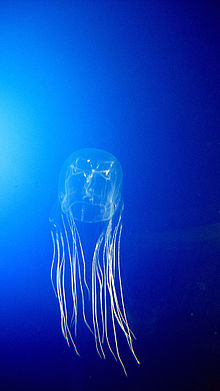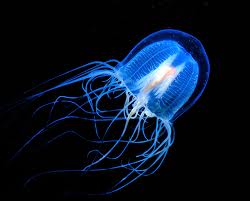Jellyfish

One of Australia's Dangerous Sea Creatures -
Jellyfish
are plentiful in both numbers and varieties around Australia's coastline, mainly found in saltwater, however there are small freshwater types called - Craspedacta, which live in lakes. - They are invertebrate animals - they have no backbone and are coelenterates - hollow-gutted.
- They are related to Coral polyps and Sea Anemones.
- True jellyfish are called medusae, and they are a pulsating, cup-shaped body with stinging tentacles hanging below.
- They reproduce by hatching eggs into tube-shaped swimming larvae, which divide to develop into many dome-shaped adults.
Another species are called Aurelia, whose tentacles hang from their rims.
The larger blue or brown jellyblubber - Catostylus mosaicus - are found in large numbers in tidal inlets. - The tentacles trailing from its centre can cause skin rashes and mild stings to people.
- The mauve stinger - Pelagia noctiluca - drifts south from tropical waters and its sting is dangerous.
- The cubomedusae are box-shaped with thin tentacles and include the deadly Sea Wasps found in Northern Australian Waters.
- The Australian Box Jellyfish can also be known as a "sea wasp" or "sea stinger" and is a very dangerous marine creature that inhabits Australian Waters.
- The tentacles contain extreme toxins, which if they come in contact with a human being, can in as little as 3 minutes, stop the heart from functioning.
- These tentacles can be up to 80 cms long and there can be up to 60 tentacles and each tentacle contains 5,000 stinging cells, which can then have enough toxins to kill 60 people - if stung you are likely to feel:-
- Agitation, confusion, unconsciousness, which could then be followed by respiratory failure.
- The Box Jellyfish, (Chrionex) has caused more deaths in Australia than Salt Water Crocodiles, Sharks or Snakes.
- It has a square body, and is found in the north east regions of Australia.
- This marine creature should always be treated with respect - remember - you're in their territory.
- Are more prevalent from October to May. mainly The Great Barrier Reef region.
Treatments for Box Jellyfish (CHRIONEX):-

- Pour vinegar over tentacles - urine does not work on the Box Jelly Fish
- Remove tentacles with a stick
- Put pressure on limb - bandage above and below the sting - not to tight - should be able to get 2 fingers under bandage
- Splint the area - to avoid movement and keep at heart level - neutral level - above the heart - venom will spread, below the heart - swelling will increase
- Avoid all alcohol, food and medicines
- Get medical treatment ASAP
- Apply anti-venom if available
Another type is the Irukandji - Carukua barnesi - and whilst smaller in size - approximately 2.5 cms in diameter and only having 4 tentacles is also capable of causing death, this also inhabits the Northern Waters of Australia, mainly Cairns and the Great Barrier Reef, however, it has been as far south as Brisbane, for most months of the year, excluding July and August. Symptoms can occur within 5 minutes of being stung:- - intense headache, lower back pain
- muscle cramps, nausea, shooting pains, vomiting
- extreme high blood pressure
- feeling of doom and restlessness
- fluid on the lungs
- heart failure Treatments for Irukandji:-

- Pour vinegar over tentacles - urine does not work on the Irukandji
- Remove tentacles with a stick
- Bandage wound area
- Give pain killers
- Get Medical Treatment ASAP
Whilst the above information, may seem daunting to some and a turn off to go to the beach, it's not meant that way - knowledge is power and knowing how to prepare or what to expect helps people to make informed decisions and on that line brings up the topic on how to avoid being stung and to enjoy your day at the beach. Prevention Tips:- - Avoid swimming in the high Jellyfish seasons and the waters that they frequent - mainly October - May and north of Brisbane, Cairns and Whitsunday Islands.
- Use wetsuits or stinger suits - particularly those with hands, head and neck coverage.
- Use fins or swimming shoes to protect your feet.
- Be aware of warning signs and notices at any beach you go to.
- Be observant when in the water - especially those waters that are more prone to jellyfish.
- Do not pick up or touch any jellyfish that you see on the sand - they could still be life there and their BITE is worse than their BARK.
Return to Home Page
Enjoy this page? Please pay it forward. Here's how...
Would you prefer to share this page with others by linking to it?
- Click on the HTML link code below.
- Copy and paste it, adding a note of your own, into your blog, a Web page, forums, a blog comment,
your Facebook account, or anywhere that someone would find this page valuable.
|



